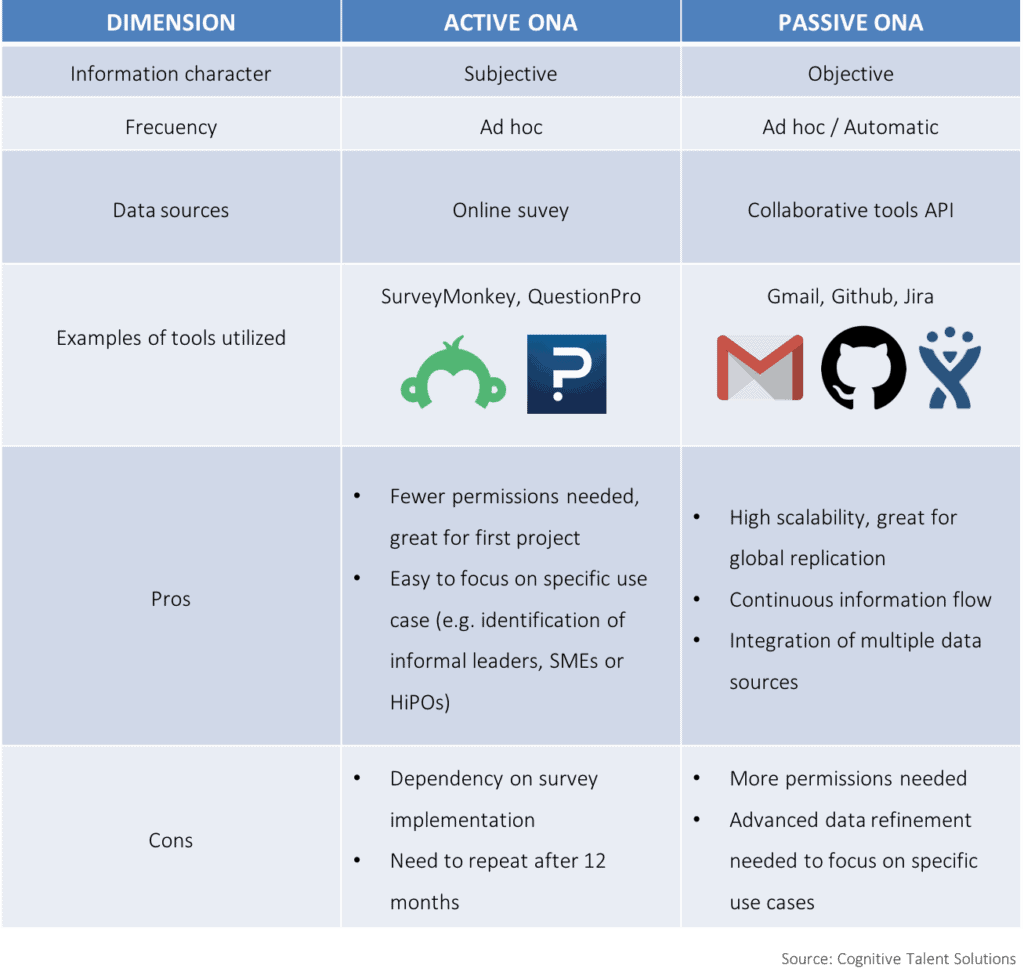[guestpost]This is a guest post by Francisco Marin Mayer. He is the co-founder & CEO of Cognitive Talent Solutions (CTS), a leading Organizational Network Analysis provider based in New York. Previously, Francisco worked at IBM as Business Analytics Leader for Sales Transaction Support EMEA Operations.[/guestpost]
Organisational Network Analysis or ONA has been making waves in the HR space.
According to the Deloitte Global Human Capital Trends report, 48% of companies are experimenting with ONA.
A survey by Insight222 identified ONA as the topic most People Analytics (PA) and HR leaders want to learn more about.
What is Organisational Network Analysis?
Organisational Network Analysis is a People Analytics method that allows your company to visualise and analyse how your employees interact in your organisation.
There are two main implementation pathways to ONA: active or passive.
Active ONA refers to implementation through an online survey, in which employees indicate who they interact with based on a series of informal metrics.
Passive ONA, on the other hand, leverages the employee’s digital footprint through the analysis of metadata from a variety of collaborative tools (e.g. email communication).
Due to its speed of implementation, companies usually embark on their ONA journey through active ONA.
Our experience has shown us that an analysis of between 500 and 6,000 employees is the favoured size to begin an active ONA pilot as it requires fewer internal permissions and takes only four weeks to conclude.
After this first project, companies are better prepared to explore the integration of passive data sources into their analysis and scale the solution at a company-wide level.
The appeal of ONA is that it allows leaders to obtain actionable insights across a variety of use cases:
- Identification of informal leaders
- Acceleration of strategic change adoption (e.g. Workday, SAP, Agile methodologies)
- Acceleration of time-to-productivity of new hires
- Measure and increase the impact of Diversity & Inclusion initiatives
- Acceleration of organisational restructuring initiatives such as mergers, acquisitions and internal reorganisations

Further examples of the benefits companies can achieve by using ONA include:
- 45% greater outreach in the implementation of any strategic change (Richard Santos’ three per cent rule indicates 3% of informal leaders can influence 85% of the population)
- Increase team collaboration by 40%
- 25% cost reduction and 80% decrease of undesired turnover in the context of internal reorganizations
- Enhanced decision-making in leadership development programs and internal promotions
- Effective Diversity & Inclusion monitoring and increase

Cognitive Talent Solutions is a leading provider in this field: recognised by David Green as among the global top 12 vendors shaping the ONA space and one of only two vendors with both active and passive ONA capabilities.
We work with Fortune500 and Global2000 companies across continents and are currently expanding operations into the Asia Pacific.
After a successful exploratory trip to wonderful Singapore earlier this year, we delighted to announce that we are back in the Lion City until the end of September.
Our goal is to meet with and introduce the benefits of Organisational Network Analysis to People Analytics and HR leaders while building a full-time presence for Cognitive Talent Solutions here in the country.
If you are a professional in the field of People Analytics and/or Human Resources, we’d love to talk with you to share and exchange insights as to the ONA revolution.
Drop us a line on info@cognitivetalentsolutions.com to schedule a product demo.
We look forward to meeting you.






